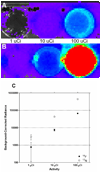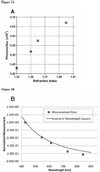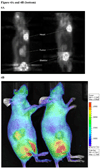Optical imaging of Cerenkov light generation from positron-emitting radiotracers
- PMID: 19636082
- PMCID: PMC2765256
- DOI: 10.1088/0031-9155/54/16/N01
Optical imaging of Cerenkov light generation from positron-emitting radiotracers
Abstract
Radiotracers labeled with high-energy positron emitters, such as those commonly used for positron emission tomography studies, emit visible light immediately following decay in a medium. This phenomenon, not previously described for these imaging tracers, is consistent with Cerenkov radiation and has several potential applications, especially for in vivo molecular imaging studies. Herein we detail a new molecular imaging tool, Cerenkov Luminescence Imaging, the experiments conducted that support our interpretation of the source of the signal, and proof-of-concept in vivo studies that set the foundation for future application of this new method.
Figures




Similar articles
-
Cerenkov imaging.Adv Cancer Res. 2014;124:213-34. doi: 10.1016/B978-0-12-411638-2.00006-9. Adv Cancer Res. 2014. PMID: 25287690 Free PMC article. Review.
-
Cerenkov luminescence tomography for small-animal imaging.Opt Lett. 2010 Apr 1;35(7):1109-11. doi: 10.1364/OL.35.001109. Opt Lett. 2010. PMID: 20364233 Free PMC article.
-
Cerenkov luminescence imaging of medical isotopes.J Nucl Med. 2010 Jul;51(7):1123-30. doi: 10.2967/jnumed.110.076521. Epub 2010 Jun 16. J Nucl Med. 2010. PMID: 20554722 Free PMC article.
-
Comments on 'Cerenkov radiation allows in vivo optical imaging of positron emitting radiotracers'.Phys Med Biol. 2010 Sep 21;55(18):L43-4; author reply L45-9. doi: 10.1088/0031-9155/55/18/L01. Epub 2010 Aug 24. Phys Med Biol. 2010. PMID: 20736495
-
Optical imaging as an expansion of nuclear medicine: Cerenkov-based luminescence vs fluorescence-based luminescence.Eur J Nucl Med Mol Imaging. 2013 Aug;40(8):1283-91. doi: 10.1007/s00259-013-2408-9. Epub 2013 May 15. Eur J Nucl Med Mol Imaging. 2013. PMID: 23674205 Review.
Cited by
-
Cerenkov luminescence imaging is an effective preclinical tool for assessing colorectal cancer PD-L1 levels in vivo.EJNMMI Res. 2020 Jun 15;10(1):64. doi: 10.1186/s13550-020-00654-w. EJNMMI Res. 2020. PMID: 32542442 Free PMC article.
-
Imaging Cherenkov photon emissions in radiotherapy with a Geiger-mode gated quanta image sensor.Opt Lett. 2019 Sep 15;44(18):4546-4549. doi: 10.1364/OL.44.004546. Opt Lett. 2019. PMID: 31517927 Free PMC article.
-
Signal intensity analysis and optimization for in vivo imaging of Cherenkov and excited luminescence.Phys Med Biol. 2018 Apr 20;63(8):085019. doi: 10.1088/1361-6560/aab83b. Phys Med Biol. 2018. PMID: 29558363 Free PMC article.
-
PEGylated crushed gold shell-radiolabeled core nanoballs for in vivo tumor imaging with dual positron emission tomography and Cerenkov luminescent imaging.J Nanobiotechnology. 2018 Apr 18;16(1):41. doi: 10.1186/s12951-018-0366-x. J Nanobiotechnology. 2018. PMID: 29669544 Free PMC article.
-
Anti-CD45 radioimmunotherapy with 90Y but not 177Lu is effective treatment in a syngeneic murine leukemia model.PLoS One. 2014 Dec 2;9(12):e113601. doi: 10.1371/journal.pone.0113601. eCollection 2014. PLoS One. 2014. PMID: 25460570 Free PMC article.
References
-
- Clarke LP, Cullom SJ, Shaw R, Reece C, Penney BC, King MA, Silbiger M. Bremsstrahlung imaging using the gamma camera: factors affecting attenuation. J. Nucl. Med. 1992;33:161–166. - PubMed
-
- Collins GB, Reiling VG. Cerenkov Radiation. Phys. Rev. 1938;54:499–503.
-
- Elrick RH, Parker RP. The use of Cerenkov radiation in the measurement of beta-emitting radionuclides. Int. J. Appl. Radiat. Isot. 1968;19:263–271. - PubMed
-
- Jelley JV. Cerenkov radiation and its applications. Br. J. Appl. Phys. 1955;6:227–232.
-
- Kelloff GJ, Hoffman JM, Johnson B, Scher HI, Siegel BA, Cheng EY, Cheson BD, O'Shaughnessy J, Guyton KZ, Mankoff MA, Shankar L, Larson SM, Sigman CC, Schilsky RL, Sullivan DC. Progress and Promise of FDG-PET Imaging for Cancer Patient Management and Oncologic Drug Development. Clin. Cancer Res. 2005;11:2785–2808. - PubMed
MeSH terms
Substances
Grants and funding
LinkOut - more resources
Full Text Sources
Other Literature Sources
